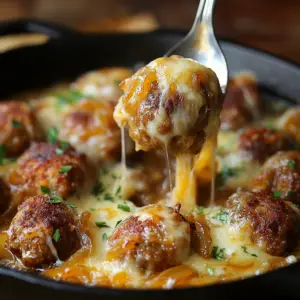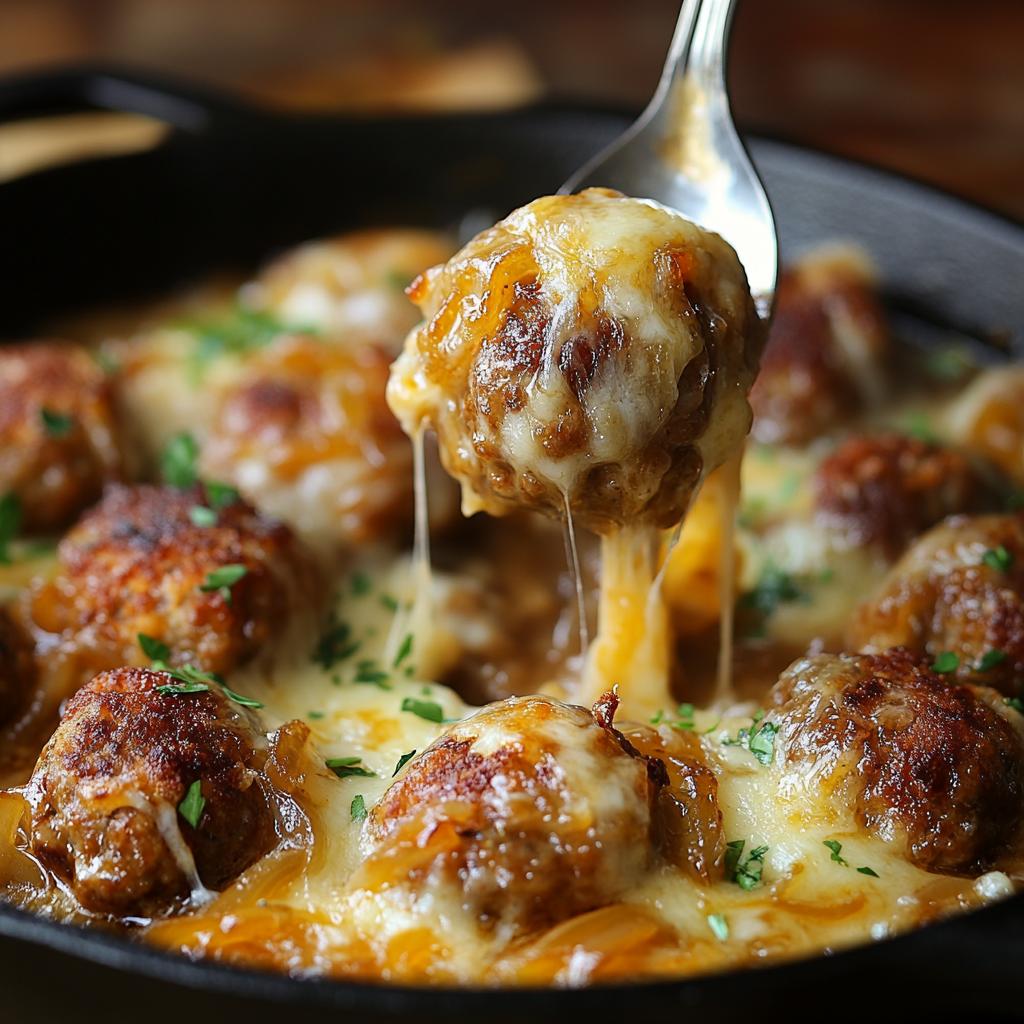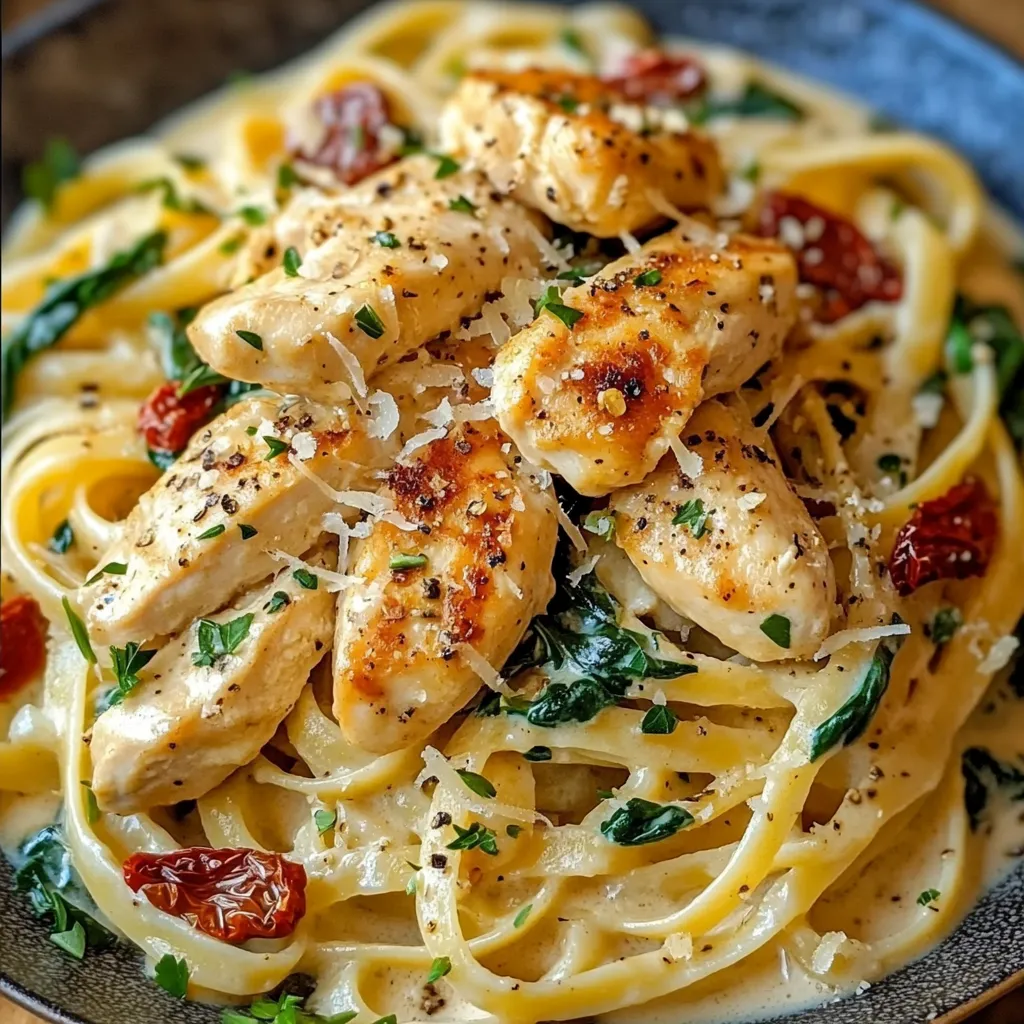French Onion Meatballs combine the best elements of two beloved dishes: savory meatballs and the rich, caramelized flavors of French onion soup. This recipe brings together the heartiness of juicy, flavorful meatballs and the deep, savory notes of slowly cooked onions, topped with melted Gruyere cheese for the perfect finishing touch. It’s a dish that feels both familiar and exciting, offering a comforting twist on traditional meatballs.
Perfect for Dinner Parties or Cozy Family Meals
Whether you’re hosting a dinner party or enjoying a quiet night at home, this dish is a crowd-pleaser. The sophisticated flavors of caramelized onions and Gruyere make it elegant enough for special occasions, while the hearty meatballs keep it approachable and comforting for a family meal. The aroma alone, with onions slowly caramelizing and cheese melting under the broiler, will draw people to the table.
Rich Flavors of Caramelized Onions and Melted Gruyere Cheese
The key to this recipe’s irresistible flavor lies in the rich, sweet onions that have been caramelized to perfection and combined with a touch of wine and beef broth for depth. The melted Gruyere cheese, known for its nutty and slightly sweet flavor, pairs beautifully with the meatballs and onions, creating a satisfying, cheesy crust. Together, they provide layers of flavor that elevate this dish far beyond your typical meatball recipe.
Versatility as a Main Course or Side Dish
One of the most appealing aspects of French Onion Meatballs is its versatility. It can shine as the centerpiece of a meal, served with mashed potatoes, pasta, or crusty bread to soak up the rich onion sauce. Alternatively, it can be a flavorful side dish to accompany a larger meal, making it a flexible option for different occasions. Whether it’s the star or a supporting player, this dish promises to delight.
Key Components of the Recipe
Meatballs, French Onion Sauce, and Cheese Topping
At the heart of this recipe are three main components: tender meatballs, the rich French onion sauce, and the irresistible Gruyere cheese topping. Each element contributes something special to the overall flavor profile. The meatballs provide a savory base, while the French onion sauce brings sweetness and depth. The cheese topping adds a creamy, melty finish that ties everything together.
Why Each Ingredient is Crucial to the Flavor and Texture
- Meatballs: The ground beef, mixed with garlic, onions, and Italian seasoning, forms the backbone of this dish. The addition of bread soaked in milk ensures that the meatballs remain moist and tender, while the seasoning adds layers of flavor that perfectly complement the rich onion sauce.
- French Onion Sauce: Caramelized onions are the star of this sauce, offering a deep, sweet, and savory profile that is further enhanced by the addition of white wine and beef broth. This sauce provides the rich, comforting flavor that defines the dish.
- Gruyere Cheese: Gruyere is the perfect choice for this dish because of its smooth, melty texture and its unique flavor profile, which combines nuttiness and a slight sweetness. It adds a rich, cheesy topping that contrasts beautifully with the savory meatballs and the deep onion flavors.
Quality of Ingredients for Best Results
To truly elevate this dish, the quality of the ingredients is key. Fresh, high-quality Gruyere cheese ensures that the topping melts perfectly and imparts its signature flavor. Similarly, using fresh herbs like thyme and high-quality beef broth will enhance the richness of the onion sauce. Taking the time to select the best ingredients ensures that every bite of this dish will be full of robust flavor and satisfying textures.
Ingredients Breakdown and Their Importance
Meatball Ingredients Breakdown
- Ground Beef (80/20 Fat Ratio)
- The ideal ground beef for this recipe is 80% lean and 20% fat. This ratio provides the perfect balance between flavor and texture. The fat content keeps the meatballs juicy and prevents them from drying out during baking, while the lean portion ensures that they hold their shape and don’t become too greasy. The fat also adds a richness that pairs beautifully with the caramelized onions and melted cheese.
- Bread & Milk Mixture
- Soaking bread in milk, also known as a “panade,” is a key technique in many meatball recipes. The milk softens the bread, and when mixed with the meat, it helps bind the ingredients together while keeping the meatballs tender and moist. The bread absorbs the juices released during cooking, preventing the meatballs from becoming too dense or tough. This simple step ensures a soft, melt-in-your-mouth texture.
- Egg
- The egg acts as a binder, helping to hold the meatball mixture together during the cooking process. It ensures that the meatballs don’t fall apart while maintaining a moist and tender texture. The protein in the egg coagulates when heated, providing structure without making the meatballs too firm.
- Seasonings (Garlic, Onion, Italian Seasoning)
- Garlic and onion add aromatic depth and a savory undertone to the meatballs. Freshly minced garlic and onion also infuse the meat mixture with moisture, preventing dryness. Italian seasoning, with its blend of herbs like oregano, basil, and thyme, brings a hint of earthy and herbal flavors, complementing the richness of the beef and the sweetness of the onions in the sauce.
- Salt and Pepper
- Proper seasoning is crucial to bringing out the full flavor of the meatballs. Salt enhances the natural taste of the beef and balances the flavors of the garlic and onion. Pepper adds a subtle kick that complements the sweetness of the caramelized onions and the richness of the Gruyere cheese. Adequate seasoning is the key to a flavorful, well-rounded dish.
French Onion Components
- Yellow Onions
- Yellow onions are ideal for caramelization due to their high natural sugar content. As they cook slowly over low heat, these sugars break down and develop a deep, sweet flavor and golden-brown color. Yellow onions are less sharp than white onions, making them perfect for creating the smooth, sweet, and savory onion base that defines the French onion sauce.
- Butter
- Butter adds a rich, creamy flavor to the onions and is essential for their caramelization. It helps the onions brown evenly and adds a layer of indulgence to the final dish. The butter’s fat content helps to develop the onions’ sweetness and enhances the overall richness of the sauce.
- Garlic and Thyme
- Fresh garlic adds a pungent, savory bite to the sweet onions, while thyme, with its earthy and slightly minty flavor, deepens the complexity of the sauce. Thyme is a classic herb in French onion soup and pairs perfectly with the caramelized onions and beef, adding a layer of herbaceousness that balances the richness of the dish.
- Dry White Wine and Beef Broth
- Dry white wine adds acidity and brightness to the sauce, cutting through the richness of the onions and meatballs. It also helps deglaze the pan, lifting all the flavorful caramelized bits from the bottom. The beef broth provides depth and a savory backbone to the sauce, enriching the overall flavor profile. When choosing a wine, opt for a crisp, dry variety like Sauvignon Blanc or Pinot Grigio, which won’t overpower the dish but will enhance the savory elements.
- Gruyere Cheese
- Gruyere is the perfect cheese for this recipe due to its smooth, creamy melting properties and its nutty, slightly sweet flavor. As it melts over the meatballs, it forms a golden, bubbly crust that adds richness and texture to the dish. Gruyere is a classic choice for French onion soup, and its distinct flavor complements the sweet onions and savory meatballs. If Gruyere is unavailable, a good substitute would be Emmental or even Provolone for a similar melty texture and mild flavor.
Step-by-Step Instructions and Cooking Techniques
Prepping the Ingredients
Importance of Preparing Ingredients Ahead of Time
Before you begin cooking, it’s essential to have all your ingredients prepped and ready. This not only streamlines the cooking process but also ensures that everything is cooked at the right time without rushing or missing steps. Proper mise en place, or “everything in its place,” helps you stay organized and keeps your cooking experience stress-free.
How to Properly Cube Bread and Soak it in Milk
Start by cutting your white bread into small cubes, about ¾-inch each. The smaller the cubes, the quicker they’ll absorb the milk. Once cubed, place the bread in a large bowl and pour the milk over it. Let it sit for 5-10 minutes, giving the bread enough time to soak up the milk completely. The bread should be soft but not overly soggy. This soaked bread, or panade, is the secret to keeping your meatballs tender and juicy.
Prepping Garlic, Onions, and Thyme
- Garlic: Mince garlic finely to ensure it integrates well into both the meatball mixture and the onion sauce. For the meatballs, you’ll need about 3 cloves, and for the onions, just one clove is enough to enhance the sauce.
- Onions: Slice the yellow onions thinly for even caramelization. A mandolin can help you achieve consistent slices, but a sharp knife works just as well.
- Thyme: Strip the thyme leaves from their stems and chop them finely. Fresh thyme adds a fragrant, earthy note to the dish, enhancing the flavor of both the meatballs and the sauce.

Making the Meatballs
Combining the Soaked Bread, Ground Beef, Egg, and Seasonings
Once your bread has soaked and softened, break it up with your hands or a fork until it becomes a paste-like consistency. Add the ground beef, minced garlic, finely chopped onion, egg, Italian seasoning, salt, and pepper to the bowl. Gently mix the ingredients together, ensuring everything is evenly distributed. Be careful not to overmix, as this can result in dense, tough meatballs. A light hand ensures a tender texture.
Avoid Overworking the Meat
When mixing the meatball ingredients, the key is to combine them just enough to incorporate everything. Overmixing causes the proteins in the meat to bind too tightly, leading to tough meatballs. The goal is to create a mixture that holds together but remains soft.
Forming Uniform Meatballs
Using a cookie scoop helps create meatballs of uniform size, which is important for even cooking. Scoop out the meat mixture, then gently roll each portion into a ball with your hands. Aim for meatballs that are about 1 ½ inches in diameter. Placing them evenly on a baking tray ensures consistent heat circulation, which helps them cook uniformly.
Baking the Meatballs
Baking at 400°F for a Good Crust
Bake the meatballs in a preheated oven at 400°F for about 20 minutes. This temperature allows the meatballs to develop a nice golden-brown crust on the outside while keeping the inside moist and tender. If you prefer a bit more caramelization, you can briefly broil the meatballs for the last couple of minutes of baking.
Alternative Cooking Methods
- Pan-Frying: You can also cook the meatballs in a skillet. This method will give them a crispier exterior, but you’ll need to cook them in batches to avoid overcrowding the pan.
- Air Fryer: Cooking meatballs in an air fryer at 375°F for about 15 minutes gives them a crisp, golden exterior without the need for extra oil.
Caramelizing the Onions
Patience for Perfect Caramelization
Caramelizing onions is a slow process, but it’s worth the effort for the deep, sweet flavor they provide. Melt the butter in a skillet over medium heat, then add the sliced onions with a pinch of salt. Cook them low and slow, stirring occasionally, for about 20-30 minutes. The onions should gradually turn golden-brown and become soft and jammy. Rushing this process by turning up the heat will result in burned, bitter onions instead of the sweet, complex flavor you’re aiming for.
Golden-Brown Without Burning
To avoid burning, keep the heat on medium-low and stir the onions occasionally. If the onions start to brown too quickly, lower the heat. You want the sugars in the onions to develop slowly, which is what gives them their signature sweetness.
Timing for Adding Garlic
Garlic burns quickly, so add it to the onions only in the last minute of caramelization. This way, it will cook just enough to release its flavor without becoming bitter.
Creating the French Onion Sauce
Deglazing with Thyme, White Wine, and Beef Broth
Once the onions are caramelized, add the fresh thyme to the skillet. Then pour in the dry white wine to deglaze the pan, scraping up any caramelized bits stuck to the bottom. This step ensures that all the rich flavors are incorporated into the sauce. After the wine has reduced slightly, add the beef broth and let the sauce simmer for about 5 minutes to allow the flavors to meld and the liquid to reduce, concentrating the flavor.
Concentrating Flavors
As the sauce simmers, the wine and broth will reduce, intensifying the flavor. The onions will become even sweeter and more tender, and the sauce will take on a rich, savory depth that perfectly complements the meatballs.
Combining Meatballs and Onion Sauce
Transferring Meatballs into the Skillet
Once the meatballs are baked, add them directly into the skillet with the onion sauce. Gently stir to coat each meatball in the rich, caramelized onions and sauce, ensuring they absorb all the flavors.
Optional Variations
For a heartier version, you can add mushrooms or even roasted bell peppers to the sauce. These vegetables will bring additional texture and flavor to the dish, making it even more robust.
Melting the Gruyere Cheese
Broiling at 500°F
After adding the meatballs to the sauce, sprinkle the grated Gruyere cheese on top. Place the skillet under the broiler, set to 500°F, for about 4 minutes. The cheese will melt and become bubbly and golden-brown, creating a deliciously gooey topping. Keep a close eye on it to avoid over-broiling, as the cheese can burn quickly at this high temperature.
Preventing Over-Broiling
Watch the dish carefully while broiling. Once the cheese has melted and developed a golden crust, remove the skillet from the oven immediately to prevent burning.
Garnishing and Serving Suggestions
Garnishing
For an extra pop of color and freshness, garnish the finished dish with chopped parsley or thyme. The herbs will brighten up the rich, savory flavors of the dish and add a pleasant freshness.
Serving Ideas
French Onion Meatballs are incredibly versatile. Serve them over creamy mashed potatoes, buttered pasta, or even alongside a slice of crusty bread to soak up the delicious sauce. These accompaniments help balance the richness of the meatballs and onions, creating a satisfying, complete meal.
Tips for Perfect French Onion Meatballs
Tips for the Best Meatball Texture
- The Perfect Balance of Bread, Milk, and Egg
- The key to achieving tender, juicy meatballs is the right ratio of bread, milk, and egg. The bread soaked in milk (panade) prevents the meatballs from becoming dense by retaining moisture. It ensures a soft, melt-in-your-mouth texture. The egg acts as a binder, holding the meat mixture together without making it tough. The combination of these ingredients provides a cohesive structure while maintaining tenderness.
- Enhancing Flavor with a Beef and Pork Blend
- While ground beef alone works well, combining it with ground pork can enhance both flavor and texture. Pork adds a slightly sweeter and richer taste due to its higher fat content, making the meatballs even more succulent. This blend of meats creates a deeper, more complex flavor profile that pairs beautifully with the sweet caramelized onions.
Secrets to Caramelizing Onions
- Avoiding Common Mistakes
- One of the biggest mistakes when caramelizing onions is using too high a heat, which can cause them to burn before they have a chance to release their natural sugars. To avoid this, cook the onions slowly over medium-low heat. Stirring too frequently can also prevent proper browning; instead, allow them to sit undisturbed between stirs to achieve that perfect golden-brown color.
- Choosing the Right Cookware
- The right skillet makes all the difference. A cast iron or stainless steel skillet is ideal for caramelizing onions because these materials distribute heat evenly and allow the onions to brown beautifully. Non-stick pans, while convenient, won’t give you the same depth of caramelization.
Choosing the Right Wine and Cheese
- Dry White Wine for Balanced Acidity
- Dry white wine, such as Sauvignon Blanc or Pinot Grigio, adds the right amount of acidity to balance the sweetness of the caramelized onions. It also helps to deglaze the pan, lifting all the flavorful browned bits that stick to the skillet. This acidity brightens the dish and enhances the savory flavors of the meatballs and onion sauce.
- Cheese Substitutes for Gruyere
- While Gruyere is the traditional choice for its nutty, slightly sweet flavor, there are great alternatives if it’s unavailable. Provolone, Emmental, or even mozzarella can be used as substitutes. Each melts well and brings a creamy texture, though Gruyere’s complex flavor remains unmatched for the true French onion experience.
Recipe Variations and Customization Ideas
Substituting Meat or Making It Vegetarian
- Using Ground Turkey, Chicken, or Pork
- If you’re looking to lighten the dish, ground turkey or chicken are excellent substitutes for beef. Turkey and chicken have a milder flavor and lower fat content, so you may want to add a little extra seasoning or a splash of olive oil to keep the meatballs moist. Ground pork can be used for a richer, fattier meatball that adds even more flavor to the dish.
- Vegetarian Options
- To make this recipe vegetarian, you can use plant-based meat alternatives such as Beyond Meat or Impossible Meat, which have a similar texture to ground beef. Another option is to make lentil-based meatballs. Cooked lentils combined with breadcrumbs, egg, and seasonings can create a hearty and satisfying meatball with a great texture.
Add-Ins for Extra Flavor
- Experimenting with Different Herbs
- While thyme and Italian seasoning are staples, you can experiment with other herbs to customize the flavor profile. Try adding rosemary for a piney, aromatic twist or oregano for a more Mediterranean flair. Fresh parsley or basil can also add a bright, herbal note.
- Adding Mushrooms or Roasted Bell Peppers
- To enhance the richness of the sauce, add sautéed mushrooms or roasted bell peppers. Mushrooms, especially cremini or portobello, bring a deep umami flavor that complements the caramelized onions. Roasted bell peppers add a sweet, smoky element, making the dish heartier and more flavorful.
Cheese Substitutes and Dairy-Free Options
- Other Cheese Options
- If Gruyere is unavailable, cheeses like Provolone, mozzarella, or Emmental are great substitutes. Provolone and mozzarella melt beautifully, while Emmental offers a similar nutty flavor to Gruyere, making it a good alternative.
- Dairy-Free Alternatives
- For a dairy-free version, opt for vegan cheese alternatives that melt well, such as Daiya or Violife. These plant-based cheeses can provide a creamy, gooey topping while keeping the dish entirely dairy-free. Pair them with plant-based meat alternatives for a fully vegan version of French Onion Meatballs.
FAQs
What is the Best Meat to Use for Meatballs?
The best meat for meatballs depends on the texture and flavor you want to achieve. Ground beef with an 80/20 fat ratio (80% lean, 20% fat) is ideal because it balances flavor and tenderness. The fat content helps keep the meatballs juicy and flavorful without making them greasy. You can also use a combination of meats like ground pork, which adds richness and sweetness, or ground turkey or chicken for a lighter option. Each type of meat brings a different flavor and texture to the dish, so feel free to mix them based on your preference.
Can I Make This Recipe Ahead of Time?
Yes, this recipe can be made ahead of time. You can prep the meatballs and caramelize the onions in advance. Store the uncooked meatballs in the refrigerator for up to 24 hours or freeze them for longer storage. Once ready to cook, bake the meatballs as instructed. The caramelized onions can also be made ahead and stored in the refrigerator for up to 3 days. To reheat, simply warm everything on the stovetop or in the oven, adding the cheese just before serving.
What is a Good Substitute for Gruyere Cheese?
If you don’t have Gruyere, several cheeses can be substituted. Emmental, Provolone, and Swiss cheese offer similar meltability and a mild, nutty flavor. Mozzarella can also work if you want a gooey, stretchy texture. For a dairy-free option, vegan cheeses like Violife or Daiya are good alternatives that melt well and provide a similar creamy texture.
Can I Freeze French Onion Meatballs?
Yes, you can freeze both cooked and uncooked meatballs. For uncooked meatballs, place them on a baking sheet in a single layer and freeze until solid. Then transfer them to an airtight container or freezer bag and freeze for up to 3 months. To cook, thaw in the refrigerator overnight and bake as usual. For cooked meatballs, freeze them in the sauce and reheat in the oven or stovetop until warmed through.
How Long Should I Caramelize the Onions?
Caramelizing onions typically takes 20 to 30 minutes. Start by cooking the onions over medium-low heat, stirring occasionally. You’ll know they’re done when they turn a deep golden-brown color and become soft and jammy. The key is patience—avoid turning up the heat, as this can cause the onions to burn rather than caramelize.
Print
French Onion Meatballs
Description
This French Onion Meatballs recipe is a delightful fusion of two beloved comfort foods: the savory goodness of meatballs and the rich, caramelized flavors of French onion soup. Juicy meatballs are baked to perfection and then simmered in a luscious French onion sauce, topped with bubbly, melted Gruyere cheese. It’s a comforting dish that combines the heartiness of meatballs with the sweetness of caramelized onions, creating a perfect balance of savory and sweet in every bite. Whether served as a main course over mashed potatoes or alongside crusty bread, this dish is a showstopper for cozy family dinners or elegant dinner parties.
Ingredients
Meatballs
- ¾ cup cubed white bread
- ¼ cup milk
- 1 pound ground beef
- 1 large egg
- 3 cloves garlic finely minced
- 1/3 cup onion finely minced
- 1 teaspoon Italian seasoning
- 1 teaspoon sea salt
- 1/2 teaspoon ground black pepper
French Onions
- 2 tablespoons butter
- 2 medium yellow onions sliced
- 1 garlic clove minced
- 1 teaspoon chopped fresh thyme
- ½ cup dry white wine
- ½ cup beef broth
- 1 ½ cup grated gruyere cheese
Instructions
-
Preheat the oven to 400°F.
Meatballs
-
In a large bowl, combine the bread cubes and milk. Let sit for 5-10 minutes.
-
When the bread is soaked well, add the beef, onion, garlic, salt, pepper, egg and Italian seasoning. Use a cookie scoop to form meatballs and roll them into balls.
-
Arrange the meatballs on a baking tray, being careful not to crowd them. Bake at 400°F for 20 minutes.
French Onions
-
In a large skillet, melt butter over medium heat. Add sliced onion with a pinch of salt and cook for 7 minutes. Add the minced garlic and cook for a minute.
-
Add the thyme, wine and beef broth to the skillet. Stir and cook for an additional 5 minutes. Season with salt to taste.
-
When the meatballs are ready, remove them from the oven and set the oven to broiler at 500°F. Add the meatballs to the skillet with the onions and give a gentle stir to coat the meatballs.
-
Sprinkle the grated cheese on top of the meatballs and return the skillet to the oven. Broil for 4 minutes until cheese is melted.
-
Remove from the oven and garnish with optional parsley.Serve immediately.
Notes
- For best results, use ground beef with an 80/20 fat ratio to ensure juicy and flavorful meatballs.
- Take your time caramelizing the onions; the slow cooking process brings out their natural sweetness, which is key to the flavor of the dish.
- If you can’t find Gruyere cheese, substitutes like Provolone, Emmental, or mozzarella will still provide a delicious, melty topping.
- This recipe is versatile: You can swap out the beef for turkey, chicken, or even plant-based meat alternatives to suit your dietary needs.









